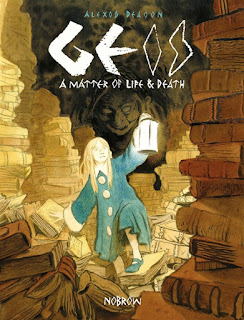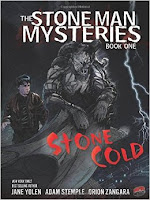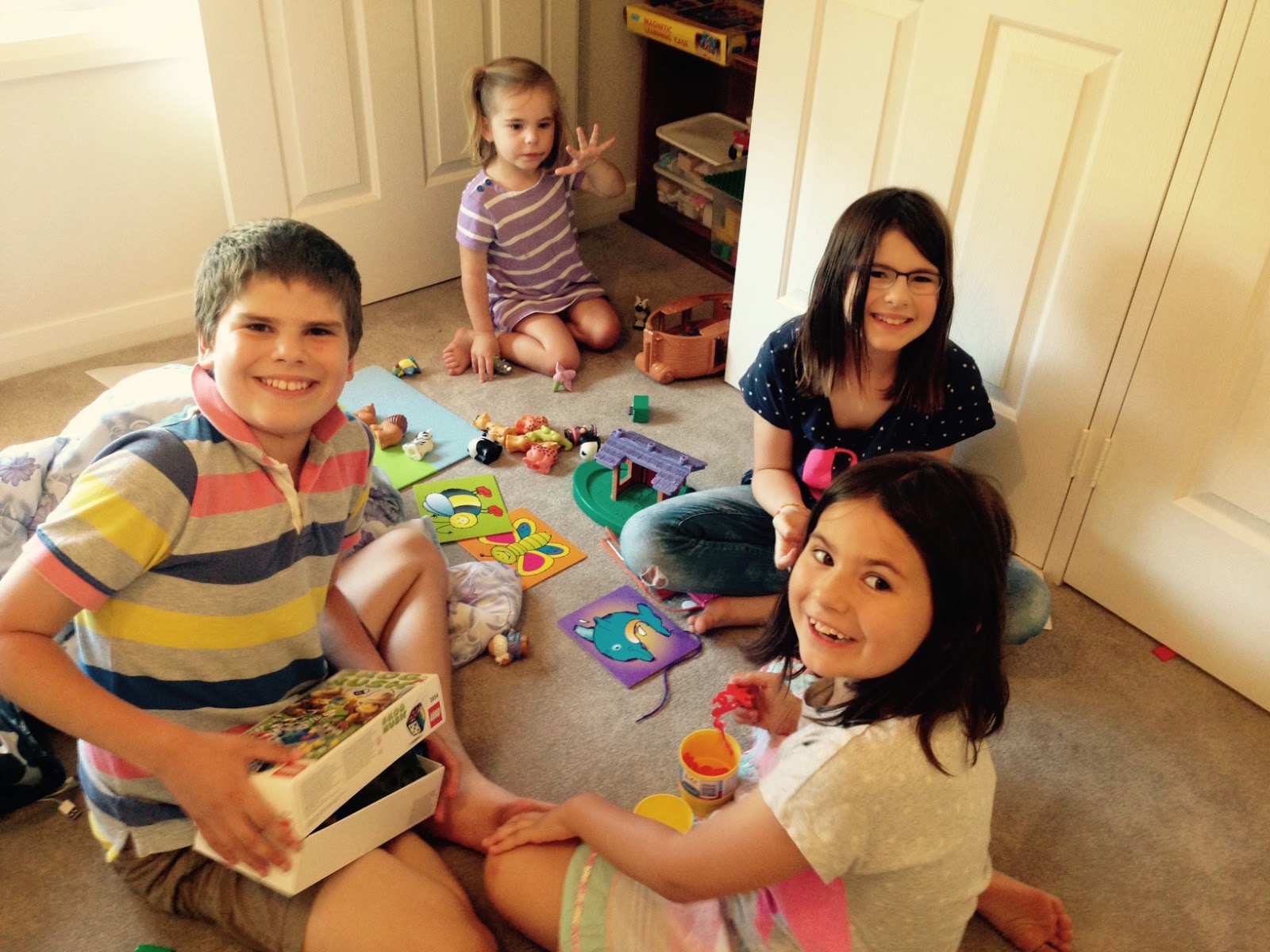1. 'Dog on a Digger - The Tricky Incident' by Kate Prendergast
This book is so good that my 5 year-old granddaughter tried to take it home the very first time she saw it - even before I'd even looked at it. Kate's magnificent crayon drawings (with a hint of colour) use soft line work to create detailed images that you want to look into for ages. The expansive scenes make you want to linger on each page. The dog who is the central character, makes you want to snatch him off the page. Here Kate allows herself a splash of yellow for his little yellow work jacket, that matches his owner's and the digger that he operates. The pair set of for an 'ordinary' day on the digger. But this day there was to be a rescue and the little dog is to be the hero. No child will want to put this book down. Delightful to share or for any 3 to 5 year old to lie on the floor with and 'read' it for themselves.
2. 'Return' by Aaron Becker
Caldecott Honour book winner Aaron Becker takes us with a lonely girl unable to get the attention of her father, back to a fantastic world where she finds friendship and adventure. This wordless book is the third part of the 'Castle trilogy'. As with the previous books in the trilogy, the central character embarks on a fantastic adventure where the imaginary and reality slide back and forth. Bored with her day at home as her dad works at his design desk, the girl draws her own doorway exit on the wall, and steps into the soft light of a forest festooned with lanterns. Once again, she finds a magical craft that takes her to the castle with her Dad in secret pursuit.
As in the previous books 'Journey' (the 2014 Caldecott winner) and 'Quest', the images are so wonderful that you need to explore every detail. There is so much depth and complexity, that repeated 'readings' will provide new insights each time. Again we are carried along by the fantasy and adventure. Will she return this time to the mundane world she left? Or will there be a return through the power of the drawn line! Marvellous!
3. 'Hilda and the Stone Forest' by Luke Pearson
The city of Trolberg has some dark secrets to reveal… and our favourite blue-haired adventurer is about to discover them! Hilda is starting to shirk her responsibilities, seeking days filled with excitement instead of spending time at home… and her mother is getting worried. While trying to stop Hilda from sneaking out into the house spirits’ realm, the pair find themselves flung far away into a mysterious, dark forest – the land of the trolls! Will they be able to work out their differences in time to rescue each other and get back home? And are the trolls all as sinister as they seem?
This visually stunning graphic novel has simple text and comic-like images that will draw readers in. The reading level is about grade 2-3 level but the content is probably more appropriate for grades 3-4. It has a dark side that for most children will be easy to handle as fantasy, but some younger children might find the world of trolls more challenging. It is a fast moving tale that has a good ending and a resolution that promises that the story is "To be continued".
4. 'Peter in Peril' by Helen Bate
Peter is just an ordinary boy, who loves playing football with his friends and eating cake - until war comes to his city and the whole family has to go into hiding...This moving, true story of the Second World War, set in Budapest, Hungary, shows in vivid words and pictures how Peter, his cousin Eva and his mum and dad bravely struggle to survive in a city torn apart by warfare.
The great strength of graphic novels is that the format lends itself to varied literary genres. This wonderful example of a graphic novel for children aged 7-10 shows how complex stories can be told in very accessible ways. It is told from the perspective and in the voice of a young child. This moving story, unlike many World War II tales, ends well. At the conclusion of Peter's story, a biographical account is also included with family photos. This book will be enjoyed and understood by primary aged children and would also be suitable as a basis for a unit of work on war as well.
5. 'Geis: A Matter of Life and Death' by Alexos Deacon
As the great chief matriarch lay dying, she gave one final decree: Upon her death there would be a contest. Having no heir of her own blood she called on the Gods. Let fate decide the one truly worthy to rule in her place. The rich, the strong, the wise, the powerful; many put forward their names in hope of being chosen. But when the night came... only fifty souls alone were summoned.
This graphic novel is the first part of a gripping trilogy. It combines supernatural and
historical fantasy in a tale where souls battle in a contest
to become the ruler of an island. 'Geis' is pronounced 'gesh' and is a Gaelic word for taboo or a curse. To have 'geis' placed on you is to have a spell that cannot be broken. A curse is at the centre of this tale told through text and water colour and black line drawings that are haunting and mysterious.
The Great Chief Matarka has died and leaves no
heir. A number are called to choose a new ruler, the Chief Judge, High Priest, Lord Chamberlain, the Grand
Wizard and daughter of the Kite Lord. However, an evil
sorceress takes control and tricks them into
agreeing to a cursed geis, that results in them all heading off on varied quests
across the land.
When readers reach the end of part one a cliff hanger will leave them wanting to continue with part 2 when it is available. Readers aged 10+ will enjoy the book.
6. 'How to Survive in the North' by Luke Healy
1912... Captain Robert Bartlett sets sail aboard the Karluk, flagship of the Canadian Arctic Expedition. The journey ahead would be one of the most treacherous ever, with the loss of the ship and subsequent deaths of the crew. The survivors, Bartlett and an Inuk companion set out across the ice for the Siberian coast, in search of help... 1926... 23-year old Inuit Ada Blackjack signs on as a seamstress for a top-secret Arctic expedition. But soon she finds herself alone and stranded in the treacherous landscape of the arctic... Present day... A disgraced university professor, tracking the lives of these survivors soon finds history repeating itself as he follows in the footsteps of those before him...
Luke Healy manages to use charmingly simple line and wash drawings, with stripped down but rich narrative. The story weaves together real life historical narratives from 1912 and 1926, with fictional narrative in the present day. It is a story about love and loss, as well as human strength in overcoming harsh conditions to survive. Readers aged 12+ will enjoy this book.
7. 'The Stone Man Mysteries - Book One' by Jane Yolen, Adam Stemple & Orion Zangara
This is Book 1 in 'The Stone Man Mysteries' and combines dark fantasy and detective work, to create stories full of suspense and stunningly detailed artwork. Orion Zangara's art alone is incredible, but adding the talents of Jane Yolen and Adam Stemple as writers, makes for a wonderful team. What an exciting series for fans of this genre.
The story is set in Scotland in the 1930s. When Craig prepares to jump from a church roof he is saved by a demon trapped in the form
of a gargoyle. 'Silex' solves murders as a way of seeking redemption, and he wants someone to run errands as part of his investigative service. But might there be an even larger, equally supernatural threat? Readers aged 12+ who enjoy fantasy will live this dark series.
8. 'A Monster Calls' by Patrick Ness (Special Collector's Edition, 2016)
This extraordinary book isn't really a graphic novel but an incredible illustrated novel for older readers. It won the Carnegie Medal and the Kate Greenaway Medal in 2012 (you can read my previous review HERE). However, it has just been released again in a well-priced Special Collector's Edition. It is an extraordinary book, on multiple levels. The book had its genesis in the final story idea of Siobhan Dowd who died in 2007 from cancer before she could act on the idea herself. Dowd was also a Carnegie Medal winner in 2009 for 'Bog Child' (awarded posthumously). Patrick Ness was approached by Walker Books and asked to take Dowd's idea, develop and complete it. Dowd had the premise for the book, the characters and the beginning. Ness never got to meet her, but agreed with a great sense of responsibility to write the story. He set out, in his words, not 'mimicking her voice' but rather taking the 'baton' and running with it. Jim Kay the illustrator was enthusiastic from the moment he read some of the manuscript and was asked to do some illustrations for one chapter. The author and illustrator didn't meet before the book was completed, but both seem to have approached the task as an unusual collaborative partnership, between three people, two living and one deceased.
'A Monster Calls' is the story of 13 year-old Conor whose mother has cancer. His parents are divorced and his father is now in another country, with a new family. His mother is undergoing chemotherapy and while there seems little hope, Conor appears to be trying to escape the scary knowledge that his mother is dying. He has a recurring dream each night at 12.07pm in which someone is slipping out of his grasp into a deep chasm. And in the midst of this dreaming he is visited by a monster. The book opens with the line: 'The monster showed up just after midnight. As they do.'
If you missed this book in 2012 don't miss it this time. A brilliant book for readers aged 12 to 99 years!
















